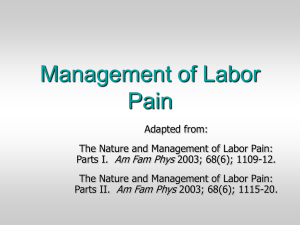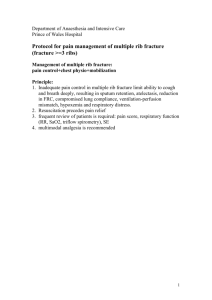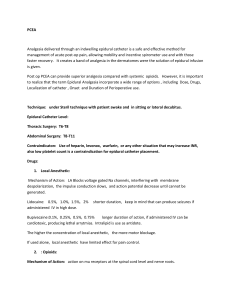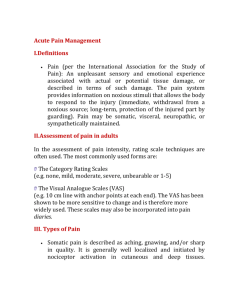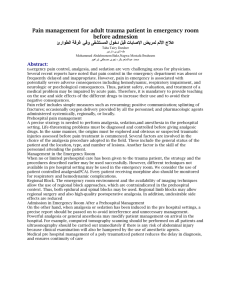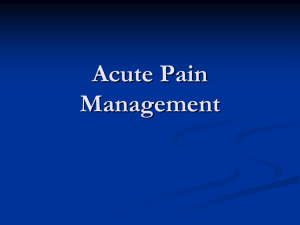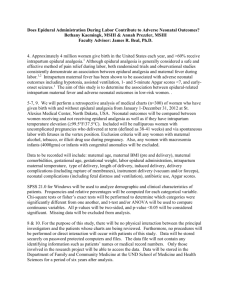Control of pain in labor 1 Introduction 2 Non-pharmacological
advertisement
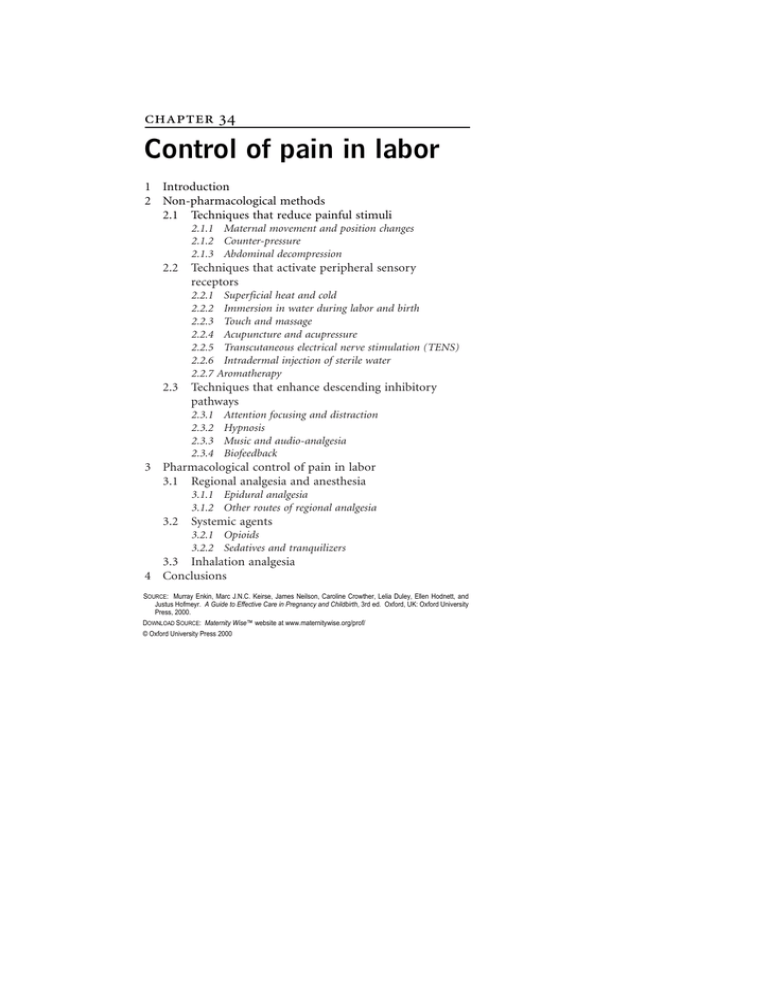
1 2 3 4 5 6 7 8 9 10 1 2 3 4 5 6 7 8 9 20 1 2 3 4 5 6 7 8 9 30 1 2 3 4 5 6 7 8 9 40 41 Control of pain in labor 1 Introduction 2 Non-pharmacological methods 2.1 Techniques that reduce painful stimuli 2.1.1 Maternal movement and position changes 2.1.2 Counter-pressure 2.1.3 Abdominal decompression 2.2 Techniques that activate peripheral sensory receptors 2.2.1 Superficial heat and cold 2.2.2 Immersion in water during labor and birth 2.2.3 Touch and massage 2.2.4 Acupuncture and acupressure 2.2.5 Transcutaneous electrical nerve stimulation (TENS) 2.2.6 Intradermal injection of sterile water 2.2.7 Aromatherapy 2.3 Techniques that enhance descending inhibitory pathways 2.3.1 2.3.2 2.3.3 2.3.4 Attention focusing and distraction Hypnosis Music and audio-analgesia Biofeedback 3 Pharmacological control of pain in labor 3.1 Regional analgesia and anesthesia 3.1.1 Epidural analgesia 3.1.2 Other routes of regional analgesia 3.2 Systemic agents 3.2.1 Opioids 3.2.2 Sedatives and tranquilizers 3.3 Inhalation analgesia 4 Conclusions SOURCE: Murray Enkin, Marc J.N.C. Keirse, James Neilson, Caroline Crowther, Lelia Duley, Ellen Hodnett, and Justus Hofmeyr. A Guide to Effective Care in Pregnancy and Childbirth, 3rd ed. Oxford, UK: Oxford University Press, 2000. DOWNLOAD SOURCE: Maternity Wise™ website at www.maternitywise.org/prof/ © Oxford University Press 2000 1 2 3 4 5 6 7 8 9 10 1 2 3 4 5 6 7 8 9 20 1 2 3 4 5 6 7 8 9 30 1 2 3 4 5 6 7 8 9 40 41 1 Introduction Women experience a wide range of pain in labor, and an equally wide range of responses to it. A woman’s reactions to labor pain may be modified by the environment in which she gives birth and the support she receives from her caregivers and companions (see Chapter 28), as well as by the methods of pain relief she uses. She will require accurate information to choose what is best for her, and reinforcement of her choice. Caregivers should ask each woman, preferably before labor begins or at least before it is well advanced, what she hopes for and expects in terms of pharmacologic pain relief. Making it easier for her to achieve her wishes is an important factor in helping her to feel good about her childbirth experience. There are a great many options, both pharmacological and non-pharmacological, from which she may choose. Although epidural analgesia is the most effective method of pain control, and is the most popular method of pain control in many countries, a number of women prefer to avoid pharmacologic methods if possible. The wish to maintain personal control during labor and birth, the desire to participate fully in the experience, and concerns about untoward effects of medications during labor, are among the factors that influence their attitudes. Because they may be helpful to all women, particularly in the early stages of labor before pharmacologic options may be appropriate, we are presenting nonpharmacological options first in this chapter. 2 Non-pharmacological methods The study of pain transmission and its modulation have produced many exciting findings, which have been applied in a variety of nonpharmacological approaches to relieving the pain of childbirth. Some of these approaches are a revival of traditional methods, while others have been newly developed. They can be usefully classified as: techniques that reduce painful stimuli; techniques that activate peripheral sensory receptors; and techniques that enhance descending inhibitory neural pathways. Many of these techniques are taught in antenatal childbirth preparation classes (see Chapter 4). 2.1 Techniques that reduce painful stimuli The most obvious solution to the problem of pain is to avoid or reduce the stimuli that cause it. In labor, the painful stimuli arise from the - 1 2 3 4 5 6 7 8 9 10 1 2 3 4 5 6 7 8 9 20 1 2 3 4 5 6 7 8 9 30 1 2 3 4 5 6 7 8 9 40 41 uterine contractions or from pressure exerted on the cervix, vagina, and pelvic joints by the presenting part of the fetus. They cannot be avoided but techniques to reduce these painful stimuli are at least theoretically possible. This is the intended purpose of various maternal positions, movement, counter-pressure, and abdominal decompression. 2.1.1 Maternal movement and position changes Laboring women find that they experience less pain in some positions than in others. If left to their own devices, they will usually select the positions that are most comfortable to them. Many laboring women today are restricted to bed, either because of cultural expectations or because of obstetrical practices, such as electronic fetal monitoring, intravenous hydration, and medications that render movement out of bed difficult or unsafe. Despite these constraints, women seem to prefer freedom of movement when it is allowed. Given encouragement to assume any position in or out of bed during the course of their labor, laboring women spontaneously adopt upright postures, such as sitting, standing, and walking, often returning to a lying-down position in advanced labor. When the mother changes position, she alters the relationships between gravity, uterine contractions, the fetus, and her pelvis. This may enhance the progress of labor and reduce pain. For example, pressure of the fetal head against the sacroiliac joint may be relieved if the mother moves from a semi-recumbent to other postures, including ‘hands and knees’, lying on her side, or various upright positions. The effects of maternal position on pain are influenced by a number of factors, including the fetal size and position, the relationship between the fetal head and the maternal pelvis, and the strength of the uterine contractions. Knowing this, experienced caregivers try not to restrict women, but encourage them to seek comfortable positions, suggest possible positions, and trust the woman’s judgement. Few data from controlled trials are available about the effects of ambulation on pain relief. No effects have been demonstrated on the use of analgesia or anesthesia. A malpositioned fetal head may result in severe back pain during labor and is associated with slow progress and increased risk of operative delivery. While there are no controlled trials of their effectiveness in labor, positions which make use of gravity and/or maximize the width of the pelvis, such as hands/knees and lunging, may help to rotate the fetal head. 1 2 3 4 5 6 7 8 9 10 1 2 3 4 5 6 7 8 9 20 1 2 3 4 5 6 7 8 9 30 1 2 3 4 5 6 7 8 9 40 41 2.1.2 Counter-pressure Counter-pressure consists of steady, strong force, applied to a spot on the low back during contractions, using one’s fist, ‘heel’ of the hand, or a firm object, or of pressure on the side of each hip, using both hands. While there are no controlled trials of its effectiveness, counterpressure appears to alleviate back pain in some laboring woman. It seems to be most effective when a woman suffers extreme back pain, often related to an occiput posterior position. 2.1.3 Abdominal decompression Abdominal decompression (see Chapter 16) was introduced in the mid-1950s as a non-pharmacological method for shortening labor and reducing labor pain. Although anecdotal reports were positive, it has now largely disappeared from use, partly because of the lack of good evidence that it is beneficial, but also because some women found the decompression apparatus to be cumbersome, constrictive, noisy, and uncomfortable. 2.2 Techniques that activate peripheral sensory receptors 2.2.1 Superficial heat and cold Superficial heat is generated from hot or warm objects, such as hot water bottles, hot moist towels, electric heating pads, heated silica gel packs, warm blankets, baths, and showers. Superficial cold can come from ice bags, blocks of ice, frozen silica gel packs, and towels soaked in cool or ice water. In addition to possible direct effects on pain perception, several physiological responses elicited by heat and cold may indirectly result in pain relief. The therapeutic uses of heat and cold have not been evaluated in randomized, controlled trials. Observational evidence suggests that they may both be effective. The use of hot compresses applied to the low abdomen, groin or perineum, a warm blanket over the entire body, or ice packs on the low back, anus or perineum, relieves pain in labor for some women. As comfort measures, heat and cold are widely accepted, if not fully understood. 2.2.2 Immersion in water during labor and birth The healing and pain-relieving properties of water – hot or cold, flowing or still, sprayed or poured – have been hailed for centuries. In recent years, immersion in water during labor and birth has aroused interest in many countries, in response to women’s requests for this form of comfort. Practice varies widely and includes the use of showers, - 1 2 3 4 5 6 7 8 9 10 1 2 3 4 5 6 7 8 9 20 1 2 3 4 5 6 7 8 9 30 1 2 3 4 5 6 7 8 9 40 41 tubs, whirlpools, and specially designed ‘birth pools’. Women at home may use either their own household tub or a birth pool. Some hospitals allow women to bring in a birth pool, and an increasing number of hospitals are installing tubs, pools, and/or showers. There is no consistency in the criteria developed to guide practice. Guidelines may exclude some women from using a pool because of conditions such as raised blood pressure or the need for electronic fetal monitoring. They may specify a minimum cervical dilatation before entering the water, the temperature of the water, and whether or not women are allowed to stay in the water for second stage, delivery, or third stage. These guidelines have been derived from experience and theoretical considerations, as there is currently little or no evidence on which to base them. Advocates stress the relaxing effect of water, which may reduce the need for pharmacological methods of pain relief. Some suggest that immersion in water may accelerate labor, decrease blood pressure, increase the mother’s control over the birth environment, result in less perineal trauma and intervention in general, and introduce the baby into the world gently. Critics maintain that there may be an increased risk of infection for both mother and baby, possible inhibitions of effective contractions, increased risk of perineal trauma, postpartum hemorrhage, water embolus, and trauma to the baby from a labor and/or birth in water. Caregivers, too, may be at risk from infection and back injury. Recent case reports raise two other possible problems. The use of very hot water over several hours of labor has been linked to hyperthermia, possibly causing brain damage or death of the baby. A few baby deaths have been reported, when the baby was held under the water after birth, presumably in the belief that a slow transition from the water into air would result in a gentle introduction to life. Large well-controlled trials are needed to determine the safety and efficacy of immersion in water during birth, particularly in regard to potential neonatal complications. In the meantime, it would seem sensible to restrict the temperature of the water to body temperature or lower, and to bring the baby to the surface as soon as it is born. Immersion in water during labor but not during birth has been assessed in four randomized trials involving more than 1400 women. No clear benefits or complications to mothers or babies were identified, although in the most recent Canadian trial, women who used the tub reported less pain after immersion, and over 80% stated that they would use the tub in subsequent labors. 1 2 3 4 5 6 7 8 9 10 1 2 3 4 5 6 7 8 9 20 1 2 3 4 5 6 7 8 9 30 1 2 3 4 5 6 7 8 9 40 41 2.2.3 Touch and massage The use of touch in various forms can convey pain-reducing messages, depending on the nature and circumstances of the touch. A hand placed on a painful spot, a pat of reassurance, stroking hair or a cheek in an affectionate gesture, a tight embrace, or more formal purposeful massage of the hand or other parts of the body – all communicate to the recipient a message of caring, of wanting to be with her and help her. The objective of massage is to make people feel better, or to relieve pain and facilitate relaxation. Massage takes the form of light or firm stroking, vibration, kneading, deep circular pressure, continual steady pressure, and joint manipulation. One may use fingertips, entire hands, or various devices, that roll, vibrate, or apply pressure. In theory, the various forms of massage stimulate different sensory receptors. When they are discontinued, the woman’s awareness of her pain increases. In addition, the phenomenon of adaptation may diminish the painrelieving effects of massage over a period of time. Therefore, use of intermittent massage, or variation in the type of stroke and location of the touch may prolong the pain-reducing effects. None of the touch or massage techniques has been subjected to careful scientific evaluation, but the intervention seems to be harmless and is well-received by many laboring women. It can be easily discontinued if the woman wishes. 2.2.4 Acupuncture and acupressure Acupuncture consists of the insertion of strategically placed needles in any of more than 365 points along the 12 ‘meridians’ of the body. It is usually combined with an electrical current, which is believed to augment the pain-relieving effect. Practitioners vary in their choice of points, size of needle, and method of insertion. Acupuncture appears to block both sensory and emotional components of pain, but the mechanism is poorly understood. No controlled trials of acupuncture during labor have been published, despite suggestions that it might provide good analgesia. The techniques involved are complex and time-consuming, and the use of multiple needles attached to electrical stimulators is inconvenient and may immobilize the woman. Acupressure has been called ‘acupuncture without needles’. The technique involves the application of pressure or deep massage to the traditional acupuncture points, with thumb, fingertip, fingernail or palm of hand. There are no published reports of its effects, either anecdotal or scientific. Acupressure can be learned and applied by a - 1 2 3 4 5 6 7 8 9 10 1 2 3 4 5 6 7 8 9 20 1 2 3 4 5 6 7 8 9 30 1 2 3 4 5 6 7 8 9 40 41 non-professional companion of the laboring woman. Well-controlled evaluation of its effectiveness would be worthwhile to establish its place (if any) as a comfort measure for labor. 2.2.5 Transcutaneous electrical nerve stimulation (TENS) Transcutaneous electrical nerve stimulation (TENS) is a non-invasive and easy to use method, which can be discontinued quickly if necessary. Used originally for the relief of chronic pain, trauma, and postsurgical pain, transcutaneous electrical nerve stimulation has also been introduced for pain relief in labor. The TENS unit consists of a portable, hand-held box containing a battery-powered generator of electrical impulses. A low-voltage electric current is transmitted to the skin using surface electrodes, and this results in a ‘buzzing’ or tingling sensation. The laboring woman may vary the intensity, pulse frequency, and patterns of stimulation, so that she can increase, decrease, or pulse the sensations as she wishes. Safety concerns have focused on theoretically possible effects of highintensity transcutaneous electrical nerve stimulation on the fetus’ heart function, especially when electrodes are placed on the low abdomen close to the fetus. A further concern is that it may interfere with signals of electronic fetal monitors. Though no untoward effects on the fetus have been reported, there has been only one investigation of the fetal safety aspects of TENS. In 15 births, the investigators established a limit or maximum current density level at 0.5 mA/mm2 when TENS was used in the suprapubic region. No adverse fetal effects were detected. Less concern has been raised when electrodes are placed only on the back, which is where they have been placed in most studies. Transcutaneous electrical nerve stimulation for childbirth pain has been subjected to more controlled trials than any of the other modalities of non-pharmacological pain relief. Unfortunately, the results of the trials still remain inconclusive. In some studies, TENS has been reported to increase, rather than decrease, the incidence of intense pain, yet it was favorably assessed by the women who used it. Direct comparison of TENS and pethidine (meperidine) failed to demonstrate any differential effect on pain experienced, and the use of TENS has no obvious effect on the use of other forms of analgesia. 2.2.6 Intradermal injection of sterile water Controlled trials have demonstrated a dramatic analgesic effect on low-back pain in labor from intradermal injection of small amounts (0.1 ml) of sterile water at four spots in the low-back area, 1 2 3 4 5 6 7 8 9 10 1 2 3 4 5 6 7 8 9 20 1 2 3 4 5 6 7 8 9 30 1 2 3 4 5 6 7 8 9 40 41 approximately corresponding to the borders of the sacrum. This simple measure deserves further evaluation, but even on the basis of presently available data would seem worth trying. 2.2.7 Aromatherapy Aromatherapy has been used increasingly in recent years. The term refers to the use of essential oils such as lavender, rose, camomile, and clary sage. These can be administered in a variety of ways, including in oil during a massage, in hot water as a bath or footbath, directly on a taper or a drop on the palm or forehead of the laboring woman, or applied with a hot face cloth. Oils are considered to have a number of specific properties. For example, camomile is said to be calming, and clary sage to strengthen contractions by dissipating stress and tension. Aromatherapy may also reduce stress and tension among caregivers and labor companions. There are no trials of the use of these oils in labor, although there are reports that women find them comforting and effective. Randomized trials are needed to clarify the possible benefits and risks. For example, it would be helpful to have assessments of the effects on uterine action, on the use of other forms of pain relief, and possible adverse side-effects including allergic reactions, and (because laboring women may be acutely sensitive to smell) nausea, vomiting, and headache. 2.3 Techniques that enhance descending inhibitory pathways 2.3.1 Attention focusing and distraction Many methods for coping with pain involve the conscious participation of the individual in attention focusing or mind-diverting activities, designed to ‘take one’s mind off the pain.’ Attention focusing may be accomplished by deliberate intentional activities on the part of the laboring woman. Examples include attention to verbal coaching, visualization and self-hypnosis, performing familiar tasks (such as grooming and eating), concentration on a visual, auditory, tactile, or other stimulus, and patterned breathing. While patterned breathing continues to be taught in many childbirth education programs, no controlled studies have evaluated its effectiveness. The results of a small study of patterned breathing suggest that it may increase the mother’s fatigue if begun too early in labor, and should be restricted to active labor. Distraction may be a more passive form of attention focusing, with stimuli from the environment (television or a walk out of doors) or from other people drawing a woman’s attention away from her - 1 2 3 4 5 6 7 8 9 10 1 2 3 4 5 6 7 8 9 20 1 2 3 4 5 6 7 8 9 30 1 2 3 4 5 6 7 8 9 40 41 pain. It does not require as much mental concentration as deliberate attention-focusing measures, and is probably ineffective when pain is severe. Attention focusing and distraction are usually used in combination with other strategies. 2.3.2 Hypnosis Hypnosis was introduced into obstetrics in the early nineteenth century and has been used in various ways ever since. It is defined as ‘a temporarily altered state of consciousness, in which the individual has increased suggestibility’. Under hypnosis, a person demonstrates physical and mental relaxation, increased focus of concentration, ability to modify perception, and ability to control normally uncontrollable physiological responses, such as blood pressure, blood flow, and heart rate. Hypnosis is used in two ways to control pain perception in childbirth: self-hypnosis and post-hypnotic suggestion. Most hypnotherapists teach self-hypnosis, so that women may enter a trance during labor and reduce awareness of painful sensations. Among the techniques used are: relaxation; visualization (helping the woman imagine a pleasant, safe scene and placing herself there, symbolizing her pain as an object that can be discarded, or picturing herself as in control or free of pain); distraction (focusing on something other than the pain); and glove anesthesia (through suggestion, creating a feeling of numbness in one of her hands, and then spreading that numbness wherever she wishes by placing her numb hand on the desired places of her body). The woman is taught to induce these techniques herself; only rarely do hypnotherapists accompany their clients in labor. Other therapists rely almost completely on post-hypnotic suggestion. These hypnotherapists do not teach their clients to enter a hypnotic state routinely during labor, because they will not need to. Most women, they claim, will be comfortable as a result of the effectiveness of the post-hypnotic suggestions. Exceptions to this are circumstances such as forceps delivery or episiotomy and repair, for which it would be necessary to go into a trance. To date, only one randomized trial of hypnosis in labor has been reported. There was no difference in analgesia use between the experimental and control groups. The mean duration of pregnancy and the mean duration of labor were both statistically significantly longer in the hypnosis group. Hypnosis had lost its popularity among obstetricians by the early 1970s, probably due to the development of better methods of 1 2 3 4 5 6 7 8 9 10 1 2 3 4 5 6 7 8 9 20 1 2 3 4 5 6 7 8 9 30 1 2 3 4 5 6 7 8 9 40 41 anesthesia and to the amount of time required for adequate hypnosis preparation. 2.3.3 Music and audio-analgesia Music and audio-analgesia are used to control pain in numerous situations, including dental work, post-operative pain, treatment of burns, and occasionally in childbirth. Many childbirth educators use music in antenatal classes to create a peaceful and relaxing environment, and also advocate it for use during labor as an aid to relaxation. Audio-analgesia for pain relief in obstetrics consists of the use of soothing music between contractions combined with ‘white sound’, the volume of which is controlled by the laboring woman, during contractions. The only published placebo-controlled trial of audio-analgesia noted a trend towards better pain relief in the audio-analgesia group, but the effect was confined to primigravidae, and was not statistically significant. As the ‘placebo’ consisted of a lower intensity of white sound, which might have had pain-relieving qualities in itself, a true benefit of the audio-analgesia might have been masked. A number of other investigators reported a decreased use of analgesic medication and less pain with the use of audio-analgesia in non-randomized cohort studies. These results, though equivocal, merit further better controlled trials. The pleasing qualities of music may offer an added dimension beyond the distraction brought about by white sound. Music creates a pleasant and relaxing ambience, and music transmitted through earphones can block out disturbing, distracting, or unpleasant sounds. When carefully chosen, music may be used to reinforce rhythmic breathing patterns and massage strokes, or to facilitate visualizations and induction of hypnosis. Thus, music may have the potential to reduce stress and to enhance other pain-relieving measures. Music may also elicit more relaxed and positive behavior from the staff and from the woman’s chosen companions. The few small studies of the pain-relieving effects of music in labor have found positive effects. These small studies of childbirth pain, when combined with findings of the effects of music or auditory stimulation on other types of pain (e.g. postoperative pain, dental pain, pain associated with burn therapy), suggest that music has the capacity to reduce pain, at least in some circumstances. Given that there are no known risks associated with the use of music during labor, and that music preferences vary widely, women who believe some form of music may be helpful should be encouraged to try it. 1 2 3 4 5 6 7 8 9 10 1 2 3 4 5 6 7 8 9 20 1 2 3 4 5 6 7 8 9 30 1 2 3 4 5 6 7 8 9 40 41 2.3.4 Biofeedback Trials of electromyographic biofeedback taught during prenatal classes failed to demonstrate any significant effect on the use of pharmacological analgesia or other interventions during childbirth. 3 Pharmacological control of pain in labor Pharmacological control of pain in childbirth has a long history. The use of opiates was mentioned in early Chinese writings; the drinking of wine was noted in the Persian literature; and wine, beer, and brandy were commonly self-administered in Europe during the Middle Ages. Various concoctions and potions have been used over time, some inhaled, some swallowed, and some applied to the laboring woman’s skin. There have been more clinical trials of pharmacological pain relief during labor and childbirth than of any other intervention in the perinatal field. The benefits of pain relief are obvious, but the possible adverse effects on the mother or infant have received little attention in this research. The clinically important question is ‘what method will achieve an acceptable degree of pain relief while least compromising the health of the mother and child?’ 3.1 Regional analgesia and anesthesia Over the past 20 years, techniques of regional analgesia have emerged as the major approach to pain relief in obstetrics, not only for labor, but for operative vaginal deliveries and for cesarean section as well. There are many reasons for the popularity of regional analgesia. The most important are that it is more effective in relieving pain than other agents, and that the mother remains conscious. 3.1.1. Epidural analgesia The ‘gold standard’ for pain control in labor is analgesia or anesthesia via the epidural route. Regional anesthetic agents (bupivicaine, xylocaine, etc.) and opioid analgesics (fentanyl, sufentanyl, etc.) may be administered alone or in combination via the epidural route. When complete or partial motor blockade is the desired goal, local anesthetics are administered. When analgesia without total motor blockade is the goal, lower doses of local anesthetics are administered, sometimes preceded by, or in combination with, opioids. 1 2 3 4 5 6 7 8 9 10 1 2 3 4 5 6 7 8 9 20 1 2 3 4 5 6 7 8 9 30 1 2 3 4 5 6 7 8 9 40 41 Eleven randomized controlled trials have compared epidural analgesia with other forms of analgesia during labor and birth. Epidural analgesia provides better and more lasting pain relief in the first stage of labor, although a few women fail to obtain adequate relief. Adverse effects of epidural analgesia suggested by these rather small trials include increased length of first and second stage labor, increased use of oxytocin to augment labor, and greater likelihood of fetal malposition and instrumental vaginal delivery. The meta-analysis also shows a strong trend toward increased cesarean delivery with epidural analgesia. The timing of epidural analgesia may be important, as the increase in operative delivery rates in these trials were found only in women who had epidural analgesia in early labor. Further study is required to confirm or refute this, since there are as yet no randomized studies to address this important question. The increased risk of instrumental delivery associated with epidural analgesia may be reduced by careful timing of top-up doses and a liberal attitude to length of the second stage of labor. Comparisons of early versus delayed pushing in second stage under epidural analgesia suggest that delaying pushing until the fetal head is visible at the introitus will lower the risk of operative delivery. A number of complications of epidural analgesia have been reported, including inadvertent dural puncture, hypotension with associated nausea and vomiting, localized short-term backache, shivering, and prolonged labor, as well as increased use of operative vaginal delivery and cesarean section. Rare complications include neurological sequelae, toxic drug reactions, respiratory insufficiency, and maternal death. As yet unproven, but possible complications are bladder dysfunction, chronic headache, long-term backache, tingling and numbness, and ‘sensory confusion’. Randomized comparisons will be needed to confirm or refute these observations. Inadvertent puncture of the dura during the placement of an epidural block may result in severe, often incapacitating, headache. The use of a prophylactic epidural blood patch is highly effective in reducing the incidence of post-dural puncture headache. Unfortunately, no data about possible long-term effects are available. Patient characteristics such as HIV status or sepsis may contra-indicate the use of a blood patch. Epidural saline or dextran are alternatives when epidural blood patch is unsuccessful or contra-indicated. Epidural morphine has been suggested as an alternative to epidural blood patch for primary therapy, with blood patch reserved as a 1 2 3 4 5 6 7 8 9 10 1 2 3 4 5 6 7 8 9 20 1 2 3 4 5 6 7 8 9 30 1 2 3 4 5 6 7 8 9 40 41 second-line modality. Other drugs that appear to be effective include oral or intravenous caffeine, theophyllin, and sumatriptan. While there are numerous observational studies and case reports, there are few controlled trials of the various suggested treatments. Little is known about the effects of epidural analgesia on the fetus and newborn. The fetus may suffer complications as a result of maternal effects (e.g. hypotension) or direct drug toxicity, although it may benefit from increased placental blood flow. No differential effects on fetal heart-rate abnormalities or passage of meconium during labor were detected in the few trials in which these outcomes were reported. One trial compared epidural analgesia with paracervical block, and found that babies born to mothers who received the epidural analgesia were more likely to experience hypoglycemia. Further trials are need to confirm or refute this observed effect. The dose of local anesthetic used for epidurals may vary significantly among hospitals. Numerous trials, usually involving small numbers of women, have compared dose regimens of various anesthetic agents. The effort spent on these trials is disproportionate to their value, in view of the importance of clarifying the safety and efficacy of the method itself as compared to the effects of specific drugs or dose regimens. Some caregivers believe that low dose epidural analgesia will reduce the need for operative delivery by promoting freedom of movement during labor and birth, and by avoiding relaxation of pelvic musculature. To date, several trials comparing low dose with standard epidural analgesia have failed to find differences in operative delivery rates. However, while women were permitted to ambulate in the trials, they spent little time out of bed. Epidural analgesia can be administered either by continuous administration with an infusion device or by intermittent ‘top-up’ doses, by way of an indwelling catheter. In either case, care must be taken to ensure that the height of the block is carefully monitored. When used as a top-up technique, regularly scheduled top-ups provide better pain relief than top-ups on maternal demand. In healthy women, there is evidence from one controlled trial that preloading with intravenous fluids is an effective means of reducing the incidence and extent of the hypotension that so commonly occurs with epidural analgesia in labor. The relative risks and benefits of fluid preloading before epidural anesthesia in the presence of pregnancy complications, such as pre-eclampsia and cardiac disease, require further evaluation. 1 2 3 4 5 6 7 8 9 10 1 2 3 4 5 6 7 8 9 20 1 2 3 4 5 6 7 8 9 30 1 2 3 4 5 6 7 8 9 40 41 Epidural administration of opioids appears to potentiate the analgesic effect of the local anesthetic. Unwanted effects of epidural opioids include pruritus, urinary retention, and delayed respiratory depression in the mother. Almost no data from randomized trials are available to explore the possible long-term effects of epidural analgesia on either mother or baby. Observational studies of long-term maternal problems have suggested that epidural analgesia may increase the likelihood of chronic backache, headache, bladder problems, tingling and numbness, and sensory confusion, but these effects have not been investigated in the randomized trials. A single report of neurobehavioral assessments of 18-month-old children failed to detect differences between the epidural and non-epidural groups at this age. In summary, epidural analgesia is a more effective form of pain relief than alternative forms of analgesia, but it increases the likelihood of operative delivery. Little more can be deduced with confidence about its effects from currently available information. It is particularly worrying that there are so few experimentally-derived data available to assess its effects on infants or its long-term effects on the mother. Hospitals that have 24-hour epidural analgesia services have very low rates of narcotic analgesia usage in labor, but one cannot infer from this that epidural is, on balance, superior to other forms of pharmacologic pain relief. Where resources permit the various pain-relief options to be available, women’s informed preferences should guide decisions about what and how much to use. Women should be made aware that one form of care with no known risks (continuous labor support), reduces the likelihood that they will need pharmacologic pain relief in labor (see Chapter 28). 3.1.2 Other routes of regional analgesia Combined spinal/epidural techniques (intrathecal opiates in the first stage of labor, followed by epidural bupivicaine later in labor) have become popular in some hospitals. As with epidural opiates, mothers may develop side-effects of pruritus, nausea and vomiting, and urinary retention, with respiratory depression in the early postpartum period. There has been a recent upswing in interest in the use of spinal anesthesia due to the introduction of new, smaller gauge needles, which are reported to result in fewer dural puncture headaches. Caudal block is rarely used today for labor analgesia. It requires a larger dose of the anesthetic agent, results in more blocked neural 1 2 3 4 5 6 7 8 9 10 1 2 3 4 5 6 7 8 9 20 1 2 3 4 5 6 7 8 9 30 1 2 3 4 5 6 7 8 9 40 41 segments, and the spread of the anesthetic is less easily controlled than with the usual form of epidural analgesia. Failures occur in 5–10% of women due to variation in sacral anatomy. The only advantage of the caudal approach over the lumbar epidural technique is the decreased likelihood of dural puncture. There may be some useful applications for caudal block for perineal analgesia, but these have yet to be evaluated. Paracervical block provides adequate analgesia and has the advantage that it can be administered by the obstetrician, thus avoiding the need for anesthetic personnel. This form of analgesia was popular in the 1950s and 1960s, but has fallen out of favor because of reports of fetal bradycardia, acidosis, and fetal death associated with its use. 3.2 Systemic agents 3.2.1 Opioids Systemic opioids (such as pethidine) can provide some pain relief, but can have unwanted side-effects. As these effects are dose-related, the amount of analgesia achievable is limited by the side-effects of the drug. Maternal side-effects include orthostatic hypotension, nausea, vomiting, dizziness, and delayed stomach emptying. Opioids cross the placenta and this may cause respiratory depression in the baby. Trial data have shown lower Apgar scores and more neonatal behavioral abnormalities in babies of mothers who received narcotic analgesia in labor than in babies of mothers who received a placebo. There have been 16 trials comparing different opioids and different doses of opioids. Because of methodological problems and lack of consistency in reporting outcomes, it is not possible to draw conclusions about the superiority of any one drug or any dose. Self-administered intravenous pethidine results in better pain relief and a lower total dose of narcotic, than intramuscular pethidine administered by a caregiver. This suggests that self-administration may be preferable, at least for women who are already receiving an intravenous infusion. Narcotic antagonists (Naloxone, nalorphine, or levallorphan) have been administered to counteract the depressant effects of opioids, either with each dose of narcotic, or 10–15 min before delivery. The rationale was to provide analgesia with minimal respiratory depression, but narcotic antagonists also reverse the analgesic effects of the narcotics. After birth, there is a role for administration of narcotic antagonists (Naloxone in particular) to neonates depressed by narcotics. 1 2 3 4 5 6 7 8 9 10 1 2 3 4 5 6 7 8 9 20 1 2 3 4 5 6 7 8 9 30 1 2 3 4 5 6 7 8 9 40 41 3.2.2 Sedatives and tranquilizers While once a popular choice of clinicians, in the belief that they reduced anxiety and promoted sleep in early labor, sedatives and tranquilizers are rarely prescribed during labor today. The barbiturates (secobarbital, pentobarbital, and amobarbital) are no longer popular for use in obstetrics because they have no analgesic properties, and because they may have a profound depressant effect on the newborn. They are still used for their sedative effect in some countries in the early latent phase of labor. Diazepam (a benzodiazepine) can cause neonatal respiratory depression, hypotonia and lethargy, and hypothermia. 3.3 Inhalation analgesia Once popular in many countries, the use of inhalation analgesia in labor has been decreasing in recent years, primarily because it does not provide reliable or complete pain relief. Side-effects of nausea and vomiting, as well as the possibility of aspiration of gastric contents in cases of accidental overdose, further decrease the usefulness of the method. It is no longer available in many settings because of concerns about possible long-term effects of exposure to inhalation agents on the medical and nursing staff. The advantages of inhalation analgesia are that the mother remains awake and in control of the analgesia; that neither uterine activity nor ‘bearing down’ during the second stage is affected; that the duration of effect is short, which allows better control; and that no clinically important side-effects on the mother or fetus have been noted. The most commonly used inhalation analgesia agent is nitrous oxide, usually in a 50% concentration with 50% oxygen. Trials comparing 50% with 70% nitrous oxide administration showed no significant differences in pain relief in normal labors. Other inhalation analgesic agents (methoxyflurane, enflurane, isoflurane, trichloroethylene) have also been employed, but their use has been curtailed or eliminated because of the difficulty of providing adequate analgesia without inducing general anesthesia, with its inherent dangers in labor. 4 Conclusions Satisfaction in childbirth is not contingent upon the absence of pain. Many women are willing to experience some pain in childbirth, but they do not want the pain to overwhelm them. For women whose goals 1 2 3 4 5 6 7 8 9 10 1 2 3 4 5 6 7 8 9 20 1 2 3 4 5 6 7 8 9 30 1 2 3 4 5 6 7 8 9 40 41 for childbirth include the use of measures to manage pain with minimal drug use, and for those who have little or no access to pharmacological methods of pain relief, the non-pharmacological methods of analgesia in childbirth, in combination with continuous support, are useful alternatives. They cannot match epidural analgesia for analgesic effectiveness, but they seem to help some women and are not likely to have harmful side-effects. Systemic opioids can reduce pain in labor, although they do not provide as effective pain relief as epidural analgesia. Their use in effective doses is limited by their side-effects of maternal drowsiness, nausea and vomiting, and neonatal respiratory depression. These effects, plus their effect in delaying stomach emptying, must be kept in mind, particularly if general anesthesia might be required for delivery. Selfadministered intravenous opioids appear to give better pain relief with lower doses than does intermittent use, although the lack of availability of suitable infusion devices may limit widespread use. Barbiturates have no analgesic effect. Diazepam can result in neonatal respiratory depression, hypotonia and hypothermia. Inhalation agents, such as 50% nitrous oxide in oxygen, are only moderately effective analgesics, but are simple to use, have a short duration of action, and are under the control of the mother. No major side effects have been noted. Remarkably little is known about the short-term and long-term effects of epidural analgesia during labor, on women and their babies. All that can be concluded with confidence is that epidural analgesia is likely to provide more effective pain-relief during labor than alternative methods, but may result in a substantial increase in operative delivery. We need better designed trials of epidural analgesia, which examine important questions about both short- and long-term effects on the mother and baby. In view of the many important unanswered questions about the effects of epidural analgesia during labor, more randomized comparisons with alternative methods of pain relief are required. Consideration of the needs of each individual laboring woman, along with knowledge of the analgesic effectiveness and the adverse sideeffects of each form of analgesia, will help the woman to make an informed choice among the alternatives available to her. 1 2 3 4 5 6 7 8 9 10 1 2 3 4 5 6 7 8 9 20 1 2 3 4 5 6 7 8 9 30 1 2 3 4 5 6 7 8 9 40 41 Sources Effective care in pregnancy and childbirth Dickersin, K., Pharmacological control of pain during labour. Simkin, P., Non-pharmacological methods of pain relief during labour. Cochrane Library Elbourne, D. and Wiseman, R.A., Types of intra-muscular opioids for maternal pain relief in labour. Hodnett, E.D., Caregiver support for women during childbirth. Hofmeyr, G.J., Prophylactic intravenous preloading for regional analgesia in labour. Howell, C.J., Epidural versus non-epidural analgesia for pain relief in labour. Nikodem, C., Immersion in water during pregnancy, labour, and birth. White, G.E., Diazepam for pain relief in labour [protocol]. Other sources Carroll, D., Tramer, M., McQuay, H., Nye, B. and Moore, A. (1997). Transcutaneous electrical nerve stimulation in labour pain: a systematic review. Br. J. Obstet. Gynaecol., 104, 169–75. Choi, A., Laurito, C.E. and Cunningham, F.E. (1996). Pharmacologic management of postdural puncture headache. Ann. Pharmacother., 30, 831–9. Christensen-Szalanski, J. (1984). Discount functions and the measurement of patients’ values. Women’s decisions during childbirth. Med. Decis. Making., 4, 47–58. Maresh, M., Choong, K. and Beard, R.W. (1983). Delayed pushing with lumbar epidural analgesia in labour. Br. J. Obstet. Gynaecol., 90, 623–7. Russell, R. and Reynolds, F. (1996). Epidural infusion of low-dose bupivicaine and opioid in labour. Does reducing motor block increase the spontaneous delivery rate? Anaesthesia, 51, 266–73. Simkin, P. (1995). Reducing pain and enhancing progress in labor: a guide to nonpharmacologic methods for maternity caregivers. Birth, 22, 161–71. 1 2 3 4 5 6 7 8 9 10 1 2 3 4 5 6 7 8 9 20 1 2 3 4 5 6 7 8 9 30 1 2 3 4 5 6 7 8 9 40 41 Vause, S., Congdon, H.M. and Thornton, J.G. (1998). Immediate and delayed pushing in the second stage of labour for nulliparous women with epidural analgesia: a randomised controlled trial. Br. J. Obstet. Gynaecol., 105, 186–8.

